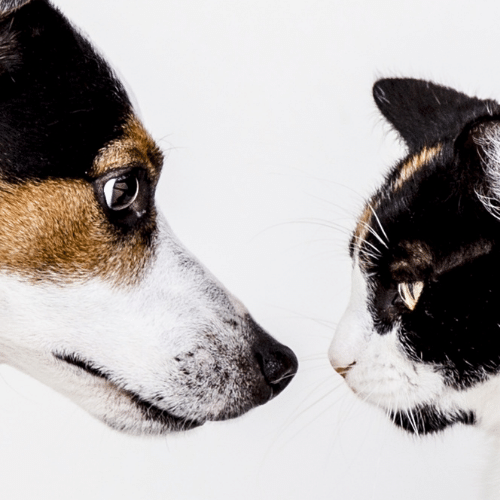Can Rescue Dogs Live With Cats?
February 12, 2022 2022-03-09 6:26Adopting your pets is a loving and compassionate thing to do. You’re saving lives while opening up spaces in the rescue or shelter for another animal that needs help. You may come across the cutest dog that needs a home and feel compelled to fill out the adoption application, but one thing stops you. Your cats! Will they get along with a dog? Will a dog get along with them?
Many people believe cats and dogs are natural enemies. After all, cartoons and stories have led us to believe this. In reality, cats and dogs can share the same home happily AND peacefully! These two are not enemies by nature. In fact, cats and dogs that are raised together can actually become good friends who share a strong bond.
Table of Contents

Can I Adopt a Dog if I Have a Cat?
You certainly can, but you have to do some research first. Not all dogs will be good with cats, and not all cats will be good with dogs. The two aren’t enemies, but each animal has their own personality, fears, preferences, and temperament.
Sometimes, it’s not even about the species. Some cats don’t get along with other cats and some dogs don’t get along with other dogs. It comes down to the individual animal.
For the most part, cats and dogs get along well if they are raised together. Having them both from a young age will usually always ensure they like and get along with each other. At the very least, they will ignore each other, which is better than being at odds.
When you’re choosing a dog to adopt, there are a few things to consider first.
The Dog’s Breed
Some dogs have high prey drives. This is something they are born with, and it can’t be trained out of them. It’s an instinct. The reason your dog takes off after the squirrel is not that they hate the squirrel, but because they have the instinctual need to do it.
Dog breeds known to have strong prey drives are:
- Australian Cattle Dogs
- Doberman Pinschers
- Jack Russel Terriers
- Siberian Huskies
- Yorkshire Terriers
- Whippets
- Beagles
- Rhodesian Ridgebacks
- Shiba Inus
- Weimaraners
This list is not exhaustive. All dogs can have some prey drive instinct (even tiny Toy Poodles might try to chase cats!). Greyhounds who are used for racing were trained to chase small animals. The instincts of the breed will be a determining factor in whether a rescue dog can live safely with cats.
Additionally, some dogs might have experienced the thrill of chasing cats in their prior home. Once a dog knows “how fun” it is to race after a cat, it is unlikely the dog will ever be completely calm around a cat.
The Dog’s Age/Size
A younger dog is more adaptable and may not have experience chasing prey. They might be curious about the cat, but not want to automatically start chasing them around the house. Puppies are much easier to introduce to cats than a dog who is a few years old and has experience chasing rabbits and squirrels.
A smaller dog, like a lap dog, is usually a safe option to live with a cat because they are tiny and easier to control. However, it’s important to remember that any dog can have a prey drive and if a small dog chases your cat, they can still cause an injury. If your cat has claws and feels like defending themselves, they could cause injury to your dog, as well.
Introducing Your Rescue Dog to the Cat
Never leave your dog and cat alone together unless you are positive that they won’t hurt one another.
That said, it’s more common for people who have a cat to want to adopt a dog than people who have a dog wanting to adopt a cat. Although the latter does happen, the dog is usually added to the home after the cat is already there. This means the cat felt like the ruler of their domain and now another animal is in their home. Permanently.
Introductions between the two have to be done slowly, with patience, and without expectations. Your animals will decide when they are used to one another and feel comfortable. No amount of force will make it happen faster.
The important things to remember when introducing these two are the same whether you’re bringing a dog home to a cat or a cat home to a dog. It’s not impossible and can be done using the right methods.

Have a Plan
Before bringing your dog home, there must be a plan in place for the safety and comfort of your cat. Your cat, depending on their personality, may feel very threatened by the presence of this new addition.
Keep Them Separated
Your dog is excited and eager to explore their new home. That’s certainly understandable, but it is important to not let the dog run in and terrify your cat. It’s a good idea to separate your cat first in a secure part of the home to which the dog has no access. Then, you can let your dog run around and explore all they want.
In doing this, your dog will already smell the cat without being able to see them. Once the dog seems to have settled, take them outside for a walk or playtime and let your cat come out of seclusion. Now your cat can walk around and smell the dog without seeing them.
Introduce Slowly
When you bring your dog back inside, you can let the two meet face to face when the dog is still on the leash. This will prevent them from being able to bolt after the cat. There’s no guarantee your cat will stick around for this meeting, either. If they choose to retreat to a place where they feel safe, let them.
This safe place for your cat could be under the bed, in a cat tree, behind furniture, or up on a bookshelf. Wherever they choose to go, let them know this is okay. Keep your dog leashed in the house until proper introductions have been made.
Once the two have sniffed each other with no hissing or scratching from the cat and no chasing from the dog, you can allow your dog off the leash to see what they do. If the first thing they do is bolt after the cat, reattach the leash and start the process over again. Reward your dog for smelling the cat and not reacting aggressively. Talk to them in calm, soothing voices and show your dog that treating the cat gently is the behavior you want to see.
Be firm in your actions so that both animals know they can trust you and that you’re in charge. If they know you will keep them safe, they can relax more around each other.
Don’t Punish
If the introduction doesn’t go as you’d hoped, avoid punishing your pets. If you discipline them, they may feel like the other animal is more welcome in the home than they are. Use positive reinforcement when you see them getting along. If they know this pleases you, they’ll continue to do it. You will reinforce the good behavior this way.
Adopting a Cat-Tested Dog
When you’re interested in adopting a certain dog, ask the rescue workers about the dog’s history. Some of their background might be known, such as if they lived with cats before or if they’ve been cat-tested.
If the dog has a history of chasing and killing small animals, it’s risky to bring this dog around cats. A cat is just another small animal to them. They don’t the difference between this and a prey animal.
Some shelters will test the dog’s reaction to seeing a cat. This includes but is not limited to the following:
- Walking a dog on a leash and allowing them to see a cat
- Walking a dog on a leash past a cat
- Holding a dog’s leash while a cat is brought into the room
- Allowing a cat to walk around the room while the dog is on a leash
- Letting both the cat and dog walk around the room together
If the dog shows signs of aggression, the shelter may deem the dog unable to live with cats. This is important information to note when you’re looking to adopt. If the dog was cat-tested and failed, that’s not a dog you can bring home to your feline.
If the dog is curious about the cat or ignores the cat completely, they are labeled as having a chance to live with cats, rather than being denied altogether.
Assessing a dog’s friendliness towards cats isn’t easy and some of the tests can cause distress to the cat. Some shelters don’t cat-test their dogs at all because of this.
Dogs in Foster Homes
The best way to know if your dog is going to be good with your cat is if they live in a foster home that has cats. Many rescues operate as foster-only. This means animals can be saved even if there is no facility to house them. People take the animals in and care for them until permanent homes are found.
Many foster homes foster more than one animal at a time. The fosters may also own animals that live with the foster animals. This means you can browse the dogs and see which are already living peacefully with cats. This is a surefire way to already know the dog is desensitized to cats and doesn’t want to chase them. You also have the added bonus of being able to ask the foster about the dog’s personality.
Dogs With Other Cats
Sometimes your dog can get along fine with your cat at home but want to chase every cat and small animal they see outside. This is not abnormal. It means they recognize that your cat is their family member and every other animal is fair game.
You’ve Tried and It Doesn’t Work
Even despite your best efforts, sometimes you can’t get your dog and cat to live peacefully together. If the situation is out of control, consider a dog trainer or animal behaviorist. Discussing your situation with a professional can give you some ideas that you haven’t thought of yet. They may even be able to come to your home and assess the situation.
With their help, you can learn how to more easily meet the needs of your dog and cat so they feel more comfortable together.

When To Leave Your Animals Alone Together
Do not do this before you are comfortable and sure that the two won’t harm one another.
When the cat can walk by a dog without the dog reacting, it’s a good sign the dog has accepted the cat’s presence. Your cat no longer hissing or growling is also a sign that acceptance is occurring.
If your dog is still trying to chase the cat, emitting any high-pitched whines when they see the cat, panting, or frantically trying to smell the cat, the two aren’t ready to be left alone together. If you’re leaving the house, separate them until you return.
If you’re able to comfortably relax with both animals in the room, try leaving that room and seeing what they do. Do they remain calm? Can they each walk by the other and not react? Does your dog immediately go for the cat when you’re not in the room any longer?
By assessing what they do when they’re not in your presence, you’ll be able to know if they will get along without you. If you try this, keep the trips short at first. Try leaving the house for a few minutes and then coming back inside.
The bottom line
Rescue dogs can live with cats if they are breeds with lower prey drives and don’t have a history of chasing and killing small animals. You can find out about their pasts by asking the rescue or foster home about the dog’s story. If they have shown any signs of aggression towards small animals in the past, they likely aren’t safe to live with cats.
If you find a dog that is fine with cats, keep the introductions slow and steady. Over time, your dog and cat will be able to live together peacefully.

Author: Jessica Rossetti
Jessica lives in Chicago with her husband, Dominic, and their rescued cat, Toast. She has lived with dogs for over 30 years and spends her days writing, caring for various animals, and enjoying her backyard that has become an oasis for wild creatures.
Her passion for animals began at a young age when she would bring home the lost dog or cat. As she got older, she went on to bring home an injured bird or raccoon. This love and desire to help all creatures led to her work as an adult with various animal rescues, where she saved the lives of many domestic and wild animals while learning the necessary skills to care for them.
Owning and operating a professional pet care service in Chicago for the past twelve years, Jessica cares for dogs in her home while writing full-time.

